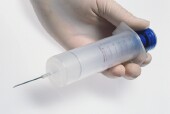
THURSDAY, May 16 (HealthDay News) — The tainted steroid injections linked to 55 recent U.S. deaths also caused many less lethal infections, more than half of them concentrated in Michigan, federal health officials reported Thursday.
Spinal meningitis deaths caused by contaminated back-pain treatments made the news for weeks last fall. But less attention was paid to a host of spinal or near-spinal infections without meningitis that were reported later in the outbreak. As of the first week of May, they had affected 320 people nationwide, with 52 percent of those cases in Michigan.
“Michigan has reported the highest percentage of cases even though we received only 13 percent of the contaminated drug that was shipped nationally,” the report’s co-author, Mawuli Nyaku, epidemic intelligence service officer at the U.S. Centers for Disease Control and Prevention, said Thursday.
The reasons for that disproportionate rate aren’t clear, Nyaku said. Nor is it known if more cases will surface.
“We are not out of the woods yet,” Nyaku said. “We have never seen anything like this before.”
Because the time from injection to symptoms of illness isn’t really known, more people who received the tainted drug may develop infections, Nyaku said. “Physicians are seeing patients who have developed infections 200 days after receipt of injection,” he said. He urged doctors to consider the possibility of infection in anyone who received the epidural injections.
The infections — whether leading to meningitis or not — are caused by a fungus called Exserohilum rostratum (basically a common black mold) that contaminated vials of steroids produced by the now-shuttered New England Compounding Center in Massachusetts.
Since first reported last September, the outbreak has sickened 741 people in 20 states and killed 55. In Michigan, 261 people developed infections and 16 died, according to the report, which was published in the May 17 issue of the CDC’s Morbidity and Mortality Weekly Report.
The localized infections, concentrated at or near the injection site, have led to abscesses, pain and some joint infections that necessitated joint replacement, Nyaku said.
These infections caught experts by surprise.
“We have known that the predominating organism was Exserohilum rostratum, which is a fungus,” said Dr. Marc Siegel, an associate professor of medicine at NYU Langone Medical Center in New York City. “What we didn’t know was that there were a series of spinal infections without meningitis.”
Nyaku said one reason for the high number of cases in Michigan is that St. Joseph Mercy Hospital in Ann Arbor saw the most patients with the infection in the country. To help identify new cases, the hospital offered MRIs to anybody who had been exposed to the contaminated steroids. “In doing so they identified additional cases, which contributed to the high number,” Nyaku said.
Another possible explanation, Nyaku said, is that more than 2,000 of the 17,000 vials of tainted drugs were shipped to Michigan. And one of the lots shipped to the state appeared to cause more infections than the other two contaminated lots, he said.
The black mold infections continue to bedevil investigators. No foolproof cure exists, and the drugs used to treat the infection are very expensive and can be toxic, he said. “When you put a patient on therapy, there isn’t a guarantee that he is going to get better,” Nyaku said.
Some patients who stopped therapy also have seen their illness return, he said.
More information
For more information on fungal infections, visit the U.S. Centers for Disease Control and Prevention.

